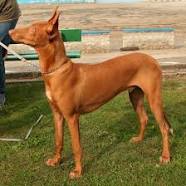ut66
Tag: pharaoh-hound
Pharaoh
The Pharaoh Hound is an ancient dog breed who has changed little since his development more than 5,000 years ago. He was the dog of kings and may have hunted gazelles with pharaohs, hence his name. This loyal hunting companion later made his way to Malta, where he’s now the national dog.
-
Highlights
- Introduce your Hound to many different people, sights, sounds, and experiences, preferably as a puppy. He can be sensitive to changes in schedules and stress, and an unsocialized dog has a harder time adapting to abrupt changes. A properly socialized is a polite and undemanding dog who is wonderful with strangers and other dogs.
- Pharaoh Hounds can get cold very easily, but they can live in a chilly climate if they’re kept indoors and wear a warm coat on wintertime walks.
- Don’t let your Pharaoh Hound run off-leash in an unfenced area. He’s got a strong prey drive and will chase other animals for miles. Backyard fences should be too high to jump or climb, and preferably solid so he can’t see through it. Underground electronic fencing won’t stop a Pharaoh Hound with something interesting in his sights.
- Pharaoh Hounds can do well in homes with other canines but smaller dogs may trigger their prey drive — as will small pets such as cats and rabbits — and some Pharaoh Hounds are aggressive toward dogs of the same gender.
- Although sighthounds are not known as barkers, the Pharaoh Hound is an exception. They bark when chasing prey, when they see intruders or hear an unusual noise, or when bored. They can indulge in long bark-a-thons, usually when you’re away from the house, which could cause problems if you live in a place with noise restrictions or neighbors that could be disturbed.
- Pharaoh Hounds are low to average shedders depending on the time of the year and the individual dog. The thin coat leaves their skin vulnerable to scrapes, tears and nicks.
- Coprophagia, better known as stool eating, is commonly seen in the Pharaoh Hound. The best way to avoid this habit is to scoop the poop right away.
- Pharaoh Hounds require at least 30 minutes of exercise per day.
- To get a healthy dog, never buy a puppy from an irresponsible breeder, puppy mill, or pet store. Look for a reputable breeder who tests her breeding dogs to make sure they’re free of genetic diseases that they might pass onto the puppies, and that they have sound temperaments.
-
History
The Pharaoh Hound is an ancient breed that originated in Egypt, and many reminders of its long history can be found in art and literature.
An artifact from 4000 BC depicts two Pharaoh Hound-shaped dogs hunting gazelles; a dog resembling the Pharaoh Hound was often depicted as the companion of kings and nobles in ancient Egyptian art; and a letter dating to the 19th Egyptian dynasty mentions a red long-tailed dog whose face glows like a God, a reference no doubt to the breed’s habit of blushing.
From Egypt, the Pharaoh Hound was imported into Malta by Phoenician traders. There they were called the “Kelb tal-Fenek,” meaning “dog of the rabbit,” after the prey the local hunters used the dog to catch. The breed thrived and became the official dog of Malta.
The Pharaoh Hound remained largely unknown in the west until arriving in England in the 1930s. The first Pharaoh Hounds were imported into the U.S. in 1967. The Pharaoh Hound Club of America was founded in 1970, and the breed was officially recognized by the American Kennel Club in 1984. The Pharaoh Hound is still an uncommon breed, but he can be found throughout the world, wherever people appreciate his unique appearance and personality.
Read more at http://dogtime.com/dog-breeds/pharaoh-hound#jFXcyE2PCarg6j1D.99

